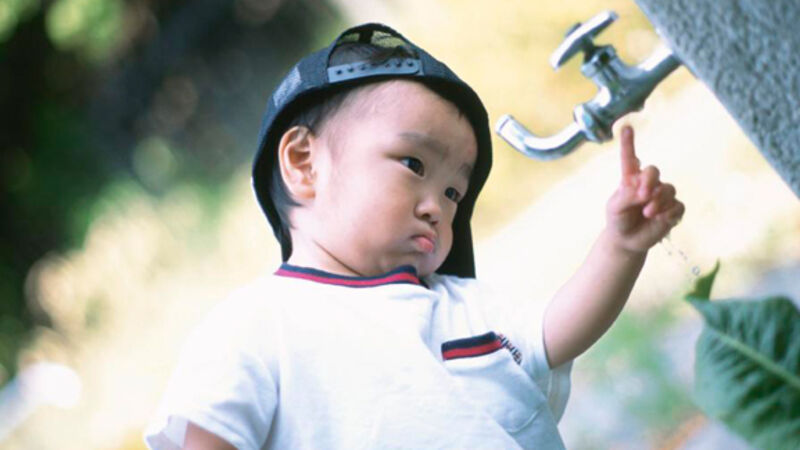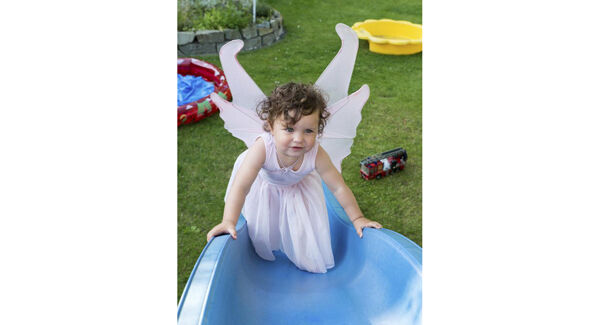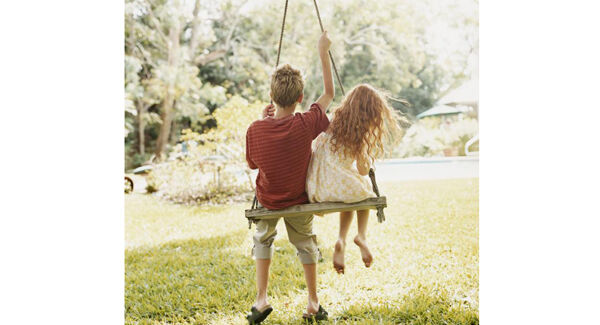The safe play code to ensure your garden can be a haven of fun

Grass nesting bees, stray rocks, the BBQ, sunburn, violent and changeable siblings — it’s a wonder any child gets out of the garden unscathed on any summer’s day.
If you’re introducing dedicated play equipment, set your little ones up for adventure and fun, not bruises, breaks and tears.
First — an important note for children
This week we’re looking at play equipment for the garden, but I’m afraid, this is really a story for Mum and Dad, and very, very boring to your bright little eyes. Kya is going to bang on and on about safety and suitability. Yawn.
Still — you know what? Once your parents have got their act together, you will be free to do what you are designed to do in the garden — and go absolutely mad!

One other thing before you run off to paint the front of the fridge with jam — make sure you get a polite say in what is bought for you to play with in the garden.
There’s nothing worse for grown-ups than seeing their hard- earned money go into a something that the dog just lifts its little fluffy leg on while you cavort around dressed in a cardboard box from Lidl.
Open your mouth and say — ‘please. I want a glider, a sand pit or a rope swing with a little climbing wall’.
The very first thing to get right in play equipment is that it is age appropriate, or should I say, appropriate to the developmental stage of your individual child.
Don’t buy things they have to ‘grow into’, as the piece may not be designed for them to safely grasp, fall from or manage.
A quality piece of equipment up to current safety standard will challenge the child physically, mentally and socially with an eye to safe play (under adult supervision for young children under six years old).
These are considerable purchases you will get little if any return on, financially at least.
We started our child’s more ambitious play at 7, with a classic DIY rope and a tyre swing, secured to a tree, raising the height as she grew and flew like a bird from an adjacent bank.
All went well, but do note — don’t choose bald steel-belted radials — the poking wires are lethal.
Second hand play equipment is not off the table and the classifieds are full of abandoned fortresses, slides and swings. However, you must check every screw, nut, bolt, plank and panel, especially for something like a play gym before purchase.

For larger pieces of equipment with timber elements look for rounded edges and corners, covers to bolts, hand grips and bumper pads — a real sign that the manufacturers are putting safety first.
Shed specialists are not necessarily garden play specialists — ask to examine the safety standards accompanying the piece (BS EN 71).
Don’t’ forget to bring the same keen eye to play equipment everywhere you go, including the gardens of friends and neighbours.
Look up and around for unusual hazards such as low tree branches, thorny bushes, walls and wires that might snag a child as they slice high through the air.
Every unit has a maximum weight limit (generally expressed in the number of children of its age group it’s intended for).
Keep any instructions and manuals and every year, go over the piece top to bottom, tightening up its elements at least twice during the summer as it accrues a few play miles.
Larger frame-style gyms with towers, platforms and ladders will require ground pegs either set into concrete or anchor-plates fastened into good clay soil and set against the legs of the unit to ensure it remains stable.
Go over the use of the piece and potential hazards with your children. A slam in the face with a hard plastic swing seat or a rope burn to bare legs is no-one’s idea of a good time.
Reduce the boo-hoo count with some common sense instructions on where to stand and how to get on.
Falls are inevitable when children play. They run faster than their legs can handle and can be complete thugs when ‘communicating’ with each other.
Let’s face it, once engrossed in a thrilling game of imagination, these kids play hard.
Soon their instincts to scale, slide, swing and bounce out on whatever is available — the garage roof, specimen tree limbs, or your listing rockery walls — will get them into trouble.
Once you have walked the territory and repeated the house rules until your eyeballs bulge and the veins in your forehead visibly throb, give the little blighters a softer place to fall.
Grass, sand and bark chippings are ideal to soak up some of the energy from an infant collapse and can be set around the base of all play equipment — slides, swings, gyms and the villain in a thousand summer falls — the trampoline.
Bark being biodegradable will break down and become slippy, and sand will leach away.
Check the depth of your landing strips every summer, topping up where needed. Loose bark, should be 50cm deep (uncompressed).
Consider the size of the safe ‘zone’ around a piece of play equipment, especially where swings and ropes can send the child into a wider orbit.
Use the lawn to protect children all over the garden and especially around swings, slides and play centres. Raise the blades on the mower to deliberately leave the sward longer and softer to elbows, knees and bare feet.
In the hotter months as clay soils can bake to concrete beneath closely clipped lawns, pick out stones and debris as they appear. Play matting in recycled rubber, can be laid over a bed or stone or to give shock absorbance over concrete or tarmac.
1m² rubber playground mats, 40mm thick and with a safe fall height of 1.8m are available from thegardenshop.ie. €35.25 each plus delivery.
Yes, children’s play and BBQs and firepits- they don’t belong in the same article as play equipment do they?
Once in the garden, the whole garden is a den of play, and no free roaming young child belongs anywhere near a hot cooking device fuelled by gas, coals or even electricity.
Set out the working area and complete traffic path used by your designated chef during the use of an outdoor kitchen area, and ban children from it entirely.
Barbeques are not only hot but pose potentially unstable obstacles supporting scalding food and sharp utensils. Lock away accelerants and all your BBQ and/or fire pit arsenal when not in use.

If you’re thinking of introducing the unquestionable joy produced by a garden trampoline, please be warned.
The American Academy of Paediatricians released a policy document in 2012 in which it strongly discouraged the use of any trampoline in a home garden, suggesting they are only ever suited to a commercial, structured setting.
Are the Americans simply over-protective scaremongers?
Chris Luke, (pictured above) head of emergency medicine at the Mercy University Hospital in Cork, is unequivocal when asked about play equipment without water.
“Trampolines are probably the most dangerous items in gardens, especially when more than two children are using them without adult supervision.
"Added to this is the risk inherent when adults decide to relive their childhood after a few drinks at the communion or confirmation party,” says Dr Luke.
Despite the clear instructions printed on the padding of every trampoline, it was found in a study in 2006 by senior house officer Cian McDermott, specialist John Quinlan and surgeon Ian Kelly from Waterford Regional Hospital, that of 88 children injured on trampolines over a six-month period, 80% were with another jumper. In 60% of the incidents, children were left unsupervised.
Trampoline-related injuries accounted for 60% of the bounce-related injuries at the Swiftcare Clinics in May last year and over the summer, more serious spinal, neck and head injuries due to the use of trampolines and bouncy castles are inevitable.
In-ground trampolines, installed correctly and with a soft surrounding surface do not eliminate the danger from children performing flips and somersaults, but will at least reduced the height from which a jumper will plummet if the netting fails.
No child under six should use a full-size trampoline. The unit should be completely dry, and detailed with a full height net. Never allow more than one child on it at a time.
A variety of weights can stall or propel lighter children erratically into the air. Finally, if you cannot trust yourself to supervise the play at all times — get rid of it.











